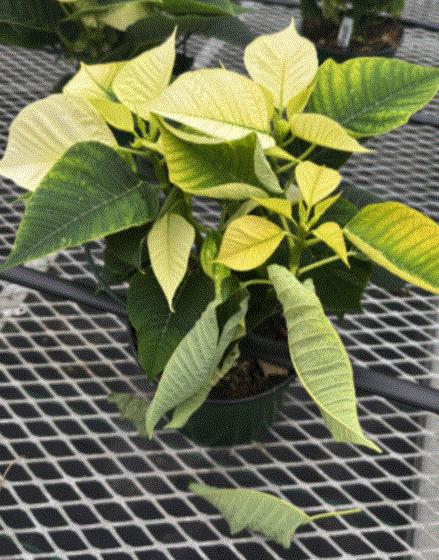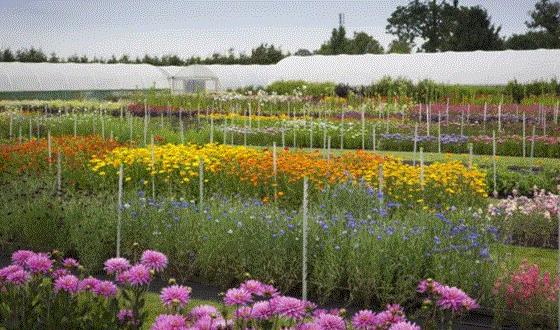VIDEO: Get Prepared for Spring!
When we first released our “In the Break Room” series, the presentations were intended as refreshers for experienced growers. But what we’ve learned over the years is that the entire PLAYLIST is most often used to help train new team members at greenhouses of all shapes and sizes, from the smallest to the largest, all across North America. With this realization, we’ve been adding training-type videos to the playlist ever since. I honestly hear from growers all the time who say they've either watched the videos or shared them and they really appreciate the info.
One of the favorites in the series is GET PREPARED—FROM CLEANUP AND MAINTENANCE TO PLACING ORDERS. In this one, Tech On Demand experts help you get ready for spring production—from sanitation and equipment calibration to dialing in your pest and disease management strategies and planning your orders to reduce shrink and ultimately make more money.
That’s a tremendous range of topics in a 40-minute discussion, so it’s not surprising that it has almost 1,000 views … but it should have even more! Here’s what you can expect to learn:
-
 Greenhouse sanitation
Greenhouse sanitation
-
Process and training
-
Chemicals
-
What to clean
-
What’s the plan?
-
Equipment calibration: lights, vents, fans, heaters, controls
-
Testing water, injectors and soil
-
Understanding your pest management “apothecary”
-
Sprays vs. drenches
-
Volume per unit area
-
FRAC and IRAC rotation
-
Biosolutions
-
Shrink management and process reviews
-
Input planning—variety selection, assessing quality, buffer strategies
-
Packaging and distribution

Nick’s Tip of the Week: Disease Pressure On The Rhiz
Each week, I’ll work with my buddy Nick Flax, a technical services expert at Ball, to share a concern that’s come up during one of his numerous calls with growers across North America. This week, he’s discussing some poinsettia symptoms he’s talked to growers about lately—and why they required a closer look from pathologists to avoid misdiagnosis of the causal pathogen.
PROBLEM: Over the last couple of weeks, I’ve received an increase in reports of symptoms consistent with Pythium in poinsettias ... at least at first glance. Chlorotic, curling, wilting leaves and bracts, discolored roots and eventual collapse of symptomatic plants ... sounds like the Pythium we all know and love, right? Interestingly, not so, in quite a few cases!

NICK’S TIP: After our plant pathology team took a closer look, they found a less-common pathogen for this time of year: Rhizoctonia solani. While root and crown rot caused by Rhizoc tends to be more prevalent during propagation and earlier in the season, monitor your crops closely for symptoms and get out in front of this issue now, rather than fight an uphill battle right before plants ship or move to retail.
What To Look For
As a soilborne pathogen, Rhizoctonia infects most often near the soil line.
-
Dark-colored, sunken cankers develop on stems first.
-
As cankers develop, they can become tannish, while borders typically remain darker colored.
-
Disease progression typically starts in the lower part of the canopy and causes branches and foliage to wilt and die.
-
When lesions girdle the stem, this completely cuts off the flow of water and nutrients to shoots above, and total plant collapse will occur.
This pathogen prefers warm conditions (68–90F [20–32C]) and moderate to high substrate moisture and high relative humidity in the lower part of the canopy.
Maturing canopies, inappropriate crop spacing, wet foliage late in the day and poor air flow through the crop can all contribute to high humidity in the lower canopy.
Though many growers are starting to drop their greenhouse temperatures to tone crops, quite a few regions in North America have experienced unseasonally warm temperatures these past few weeks. This may explain the sudden, out-of-season uptick in disease pressure.
Management
This pathogen must be managed preventatively. Focus on exclusion and crop cultural best practices from the beginning of the crop cycle, such as:
Start with clean inputs. Source cuttings and young plants from trustworthy sources. If disease occurs early in propagation or the finished crop cycle, reach out to your supplier for support.
Only use fresh growing media. Do not recycle potting mix from previously unsold crops. Similarly, plant into new containers or thoroughly clean and sanitize reused pots before planting into them.
Maintain strict footwear sanitation. Have employees clean off their shoes before entering the greenhouse, provide “greenhouse only” footwear for employees, and/or place sanitizing footbaths in high-traffic areas or near the entrances of each greenhouse.
Water early in the day. Set a goal to finish watering by lunchtime and stick to this as much as possible. Put plants on drip irrigation as early as possible to reduce canopy wetness. Or use subirrigation, if you have that type of infrastructure in place.
Minimize crop movement. Rhizoctonia needs an entry point to infect. Excessive handling or movement of plants can lead to small cuts or breaks in the stem and open the door for infection.
Provide preventative protection. Be sure to include an appropriate fungicide in your rotation that provides protection against Rhizoctonia. See fungicide recommendations below.
Outbreak Management
If you confirm the presence of Rhizoctonia in your poinsettia crop, start by roguing out symptomatic plants ASAP. Do not compost infected plants or save growing media and container—throw them away! Next, treat the crop with an appropriate fungicide, including (but not limited to):
-
Fludioxonil (ex. Medallion)
-
Iprodione (ex. Chipco 26019)
-
A strobilurin (FRAC group 11 fungicides; ex. Heritage, Pageant, Mural, Broadform)
-
Triflumizole (ex. Terraguard)
Monitor the crop for new symptoms and continue to rogue out affected plants. Also, remember that one pathogen can open the door for secondary infection. Oftentimes, Pythium can also join the party, so it would be best to treat for both pathogens together with a tank-mix fungicide drench or in close succession as separate drenches. Fungicides with active ingredients such as cyazofamid (ex. Segway), etridiazole (ex. Banrot, Terrazole, Truban), or mefenoxam (ex. Subdue MAXX) are my go-tos for Pythium prevention.

Starter Charge for Plug and Liner Prop—Yea or Nay?
One of the core functions of growing media is to be a mineral nutrient reservoir for plants. Unless you root cuttings in sand (unadvisable for vegetative annuals and perennials), most commercially produced soilless mixes have good nutrient-holding capacity. However, a common amendment in both propagation and finished mixes is a “starter charge” of fertilizer. According to Ball Seed technical services experts, there are pros and cons to the presence of a starter charge, but in most cases it’s helpful. Consider the following (if you’ve found yourself wondering whether this is necessary) next time you go to purchase soilless media.

For plug production. Presence of a starter nutrient charge can be the difference between good and excellent seedlings, especially for less-experienced plug growers. For many crops, it’s best to begin fertilizer applications at lower concentrations (50 to 75 ppm N from a complete fertilizer) once they enter Stage II—after radicle emergence and before cotyledon have fully emerged. However, I often find that growers who struggle to produce vigorous plugs wait too long to start fertilizer applications. If you’re a grower who forgets when to start fertilizer applications on your plugs, consider use of a plug mix with a starter nutrient charge to help keep your young plants on track.
The other factor is that not all of you have the infrastructure to provide plugs with low concentrations of fertilizer this early in the crop cycle. If you only have access to one injector for various ages of crops or your injector is not easily adjustable, this can make it difficult to feed plugs reliably at appropriate concentrations for young, tender plants. Accidental fertilizer applications at high rates can damage roots and cause algae to bloom on the media surface, which causes a host of other issues. To avoid this issue, if you do not have a fertilizer injector in your propagation area that can be adjusted to feed at low concentrations, inclusion of a starter charge in your plug mix is advisable.
For liner production. The logic behind the need for a starter charge in plug production may seem like an easy parallel to liner production … You should have it, right? Not really. Unrooted cuttings (URCs) lack roots when you stick them and cannot take up nutrients from the soil yet, so the presence of fertilizer in liner media is less critical early on compared with plug production. It’s best practice to apply fertilizer through the mist at low concentrations (about 50 ppm N works for many crops) until root initials form and begin to apply fertilizer to the media at 100+ ppm N once roots begin to develop. As such, the presence of a starter charge in liner media is less critical and the added cost can often be avoided with little to no impact to young plant quality. However, if you don’t monitor soil EC (electrical conductivity) regularly during liner production and find that your URCs tend to stall out and stay lighter-green during the early stages of rooting, a starter charge in your mix might be helpful.

2 New Diagnostic Guides from e-GRO
I absolutely love that some of our industry’s leading minds still create and produce hard copy crop guides. Obviously, as a book nerd, senior editor of a print magazine, huge fan of the Ball RedBook and 20-year employee of Ball (we print a lot of catalogs), I still see a ton of value in resources on paper versus screens. And I suspect many of you do, as well—even as you read this digital newsletter. No, we’re not planning to drop 26,000 paper copies of Tech On Demand in the mail each week … but I digress.
The brilliant researchers at e-GRO recently released two photographic paperback guides detailing disease, insect, nutritional and physiological problems encountered when producing common crops. Crops covered in the latest guides are marigolds and ornamental peppers. One of the best features of these guides is TONS of photos. Pictures are often the best training tools, crossing language barriers and triggering memory if and when symptoms are spotted on crops.

MARIGOLD INSIDER by Brian Whipker is a 92-page full-color guide with more than 80 photos, and ORNAMENTAL PEPPER INSIDER by Patrick Veazie and Brian Whipker is 68 pages with 86 photos. You can order them by clicking the links. The guides are less than 20 bucks each—definitely a bargain!

Trialing Cut Flowers: Best Practices from IPTC
After a couple weeks off, it’s time to get back to sharing my notes from the International Plant Trialing Conference, hosted by All-America Selections in Minneapolis last month. While most of the sessions and panels centered on ornamental and vegetable plant trials, there was also one focused on cut flower trialing and it was interesting (at least to me) to learn about the different types of assessments needed for these crops. The panel included Connie Bijl (Dan Seed), Alicain Carlson (Syngenta Flowers), Drew Groezinger (Clara Joyce Flowers) and Susie Raker (Raker-Roberta’s).

Cut flower trials may share many of the same goals as bedding or container plant trials—measuring performance, validating breeding goals and collecting data—but they come with their own unique challenges (and outputs). One major difference shared by the panelists is that if you’re trialing cut flowers, you have to cut them! Without proper harvest practices and assessments, your results will be limited.
Infrastructure & Planning
Cut flower trials require thoughtful setup. Netting and support systems, drip irrigation and shade structures are often essential to evaluate performance under both sun and shade. Most programs use field or high tunnel setups to simulate real-world production conditions.
Efficiency matters and planting is often high-density to mimic production conditions. Whether using hand planting or water wheel planters, ensure consistency in spacing, fertilization and weed management—preemergent in spring, hand weeding as needed, and granular fertilizer for balanced growth are some best practices shared by the experts.
Data Collection
Beyond standard plant health and bloom data, cut flower trials can involve additional layers of evaluation:
-
Stem length and strength
-
Best harvest time of day
-
Color consistency and bloom shatter
-
Plant health after repeated cuttings
-
Yield and regrowth over the season
Photos throughout the season are vital to document color changes, stem quality and harvest timing.
Postharvest Trialing
Once the flowers are cut, the trials continue. Vase life testing—whether conducted by breeders, universities, or through a third-party—is crucial to assess real-world performance. Some trial reports (like those published in ASCFG’s Cut Flower Quarterly) track:
-
Hydration and holding solutions
-
Cold storage duration and temperature
-
Floral preservatives and dry storage practices
-
Longevity and appearance with and without flower food
The panelists closed by agreeing that one key for all trials is not to forget the human side—take care of your crew, share the harvest and even make some arrangements for fun.
I think whether you trial flowers or not, this is just a good reminder for all of us in our amazing industry!

Finish Line …
Last week, I had the pleasure of spending a few days with a collection of young plant growers from across North America who traveled to West Chicago to meet with technical experts from Ball Seed, PanAmerican Seed, Ball FloraPlant and Darwin Perennials. The group spent time discussing specific crops, learning about offshore farm and supply chain improvements, and hearing about new research into large-scale young plant production protocols. Of course, there was plenty of time for peer-to-peer networking, and we wrapped things up with a group visit to a huge greenhouse a couple hours from Ball.
I always appreciate the opportunity to hang out with growers and pick their brains about topics to cover in Tech On Demand videos, podcasts and this newsletter. I left with a ton of ideas. I also heard from one of the attendees that they’ve been going back in the archives and listening to older podcast episodes and finding a bunch of great topics they missed the first time around when they were first released.
Which means this is as good a time as any to remind you that there are now more than 200 episodes in the Tech On Demand archive—all still available on your favorite podcast app. I’ve talked to experts about dozens of specific crops, pests, diseases, structures, marketing ideas, growing media, lighting, and countless more topics relevant to professional growers, garden center retailers, landscapers, CEA growers and more. You can find them on APPLE PODCASTS and SPOTIFY or via our RSS hosting platform, PODBEAN. Heck, you can even scroll or click all the way down to episode #1 from July 10, 2020, and hear my conversation with Dr. Aaron Palmateer about poinsettia insect control. Actually, that’s a really good one …
Until next week, stay warm—at least that’s my plan. Apparently, there’s some sort of weather pattern ripping through the Midwest in a few days that might bring snow. I'm not ready for that.




Please feel free to send your comments, constructive criticism and topic ideas to me at bcalkins@ballhort.com.

Bill Calkins
Editor - Tech On Demand
This email was received by you and 25,494 other fine subscribers!
If you're interested in advertising in Tech On Demand, contact Kim Brown ASAP and she'll hook you up.